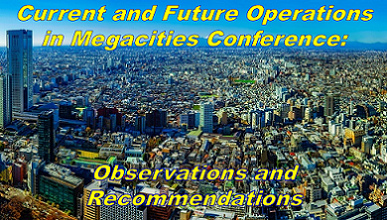[Editor’s Note: In today’s post, Mad Scientist Laboratory captures the key observations and recommendations that emerged from the Current and Future Operations in Megacities Conference, facilitated in Tokyo on 16-19 July 2019. Five partners recognized the importance of better understanding the challenges of Humanitarian Assistance / Disaster Relief (HADR) operations in the world’s largest and most influential urban areas. Representatives from the U.S. Army Pacific (USARPAC), U.S. Army Japan (USARJ), U.S. Army Training and Doctrine Command (TRADOC), and the Australian Army worked with the Japan Ground Self-Defense Force (JGSDF) in conducting this event at their Ichigaya headquarters. Speakers and attendees spanned organizations representing a comprehensive approach to contingencies (i.e., military, government civilian, nongovernmental, intergovernmental, industry, and others with talents and capabilities relevant to HADR undertakings in urban environments). The following post was excerpted from this conference’s comprehensive (155 page!) Proceedings, a link to which is provided below — Enjoy!]
“We can’t turn a blind eye to operations in megacities. We’ve got to get after this or shame on us. The more we talk, the more we share, then the more we learn…. If we continue to ignore the complexities of operating in megacities we are only putting our Soldiers and citizens in extreme danger.” — General Robert B. Brown, Commanding General, U.S. Army Pacific
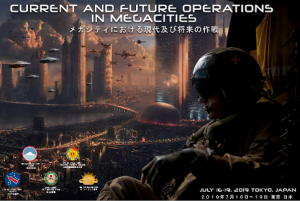 Speakers at the Current and Future Operations in Megacities Conference emphasized the need to better promote collaboration between those bringing
Speakers at the Current and Future Operations in Megacities Conference emphasized the need to better promote collaboration between those bringing
capabilities to bear during and after a megacity disaster. The emphasis was on better preparing prospective participants by including them in pre-event planning, training, and exercises and then effectively synchronizing those assets once catastrophe strikes. As is notably well done in Tokyo, this preparation and participation should incorporate members of the public. Victims recovered by community members after an earthquake survive 80% of the time versus 50% survival for others needing assistance by first responders.* The goal should be more than cooperation or coordination of partner capabilities, seeking instead the orchestration of these assets.
Preparing individual partner organizations and promoting collective capacity requires improvements in virtual and constructive training capabilities, given the impractical costs inherent in relying exclusively, or even primarily, on live training. The criticality of maintaining public trust necessitates “war gaming” HADR operations no less than is done during preparation for combat operations. Replicating Tokyo preparations for disaster (e.g., disaster preparedness map requirements, design features such as standby emergency toilets and cooking stoves in public parks) is worthy of consideration, particularly (but not exclusively) for megacities exposed to high risk of natural catastrophe.
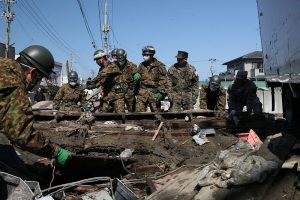
Military forces – those of the nation suffering disaster or others partnering during HADR operations – will be particularly challenged. First, there can be no lessening of armed forces’ primary mission to guarantee the security of its citizens, a duty tested in the aftermath of 3/11 (i.e., the Tōhoku earthquake and tsunami on March 11, 2011 and resultant Fukushima Daiichi nuclear disaster) when aircraft of two regional countries tested Japanese airspace. Additionally, there will be demands not only for capabilities traditionally expected of soldiers, but others as well. The Japan Self-Defense Force found itself assuming tasks normally handled by police, fire, or other civilian authorities when those assets were overwhelmed or rendered inoperable due to the devastation.
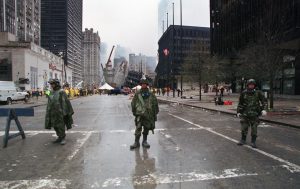
As with the demand for unflagging military diligence during times of disaster, responsibilities of civil authorities regarding public security do not take a rest. Parties providing HADR should expect resistance, theft, or other interference even in the most permissive of environments. The same social problems found in an urban area on a daily basis will be found in displaced persons facilities. In addition, criminals will capitalize on the close proximity in those facilities and dense living quarters, further burdening security with 24/7 policing requirements. Including women’s perspectives in the planning and design of displaced persons policies and facilities is essential.
Humanitarian assistance/disaster relief is too often considered merely as the sum of separate parts, rather than a synergistic whole. Preparation and funding of HADR would be better served if undertaken from a systems rather than piecemeal perspective. This more coherent approach would have multiple payoffs, to include establishment of standards for communications hardware and procedures promoting better military-civilian and civilian-civilian exchanges.
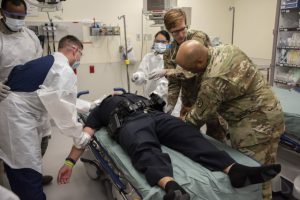
Disasters make extraordinary demands on security infrastructure, both physical and social. Laws, regulations, and policies require review and, as necessary, updating to keep pace with changing conditions and improvements in response capabilities. Restrictions on what procedures Emergency Medical Technicians (EMTs) are allowed to perform provide a case in point. While those permitted should not exceed an individual’s level of training, reconsidering what skills EMTs, paramedics, police, fire, and other personnel should have as part of their core training may require review. In addition, consideration should be given to temporarily expanding the palette of procedures allowed by select personnel under conditions such as those that will exist in times of extreme adversity.
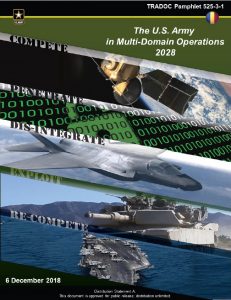 All three countries’ militaries partnering during the conference have maturing operational concepts. Multi-Domain Operations (U.S.), Cross-Domain Operations (Japan), and Accelerated Warfare (Australia) have much to offer during HADR, a potential as of yet underappreciated. In turn, these concepts would benefit from in-depth consideration of how operations in megacities would challenge nations throughout the competition-armed conflict-return to competition range of missions and strategic objectives.
All three countries’ militaries partnering during the conference have maturing operational concepts. Multi-Domain Operations (U.S.), Cross-Domain Operations (Japan), and Accelerated Warfare (Australia) have much to offer during HADR, a potential as of yet underappreciated. In turn, these concepts would benefit from in-depth consideration of how operations in megacities would challenge nations throughout the competition-armed conflict-return to competition range of missions and strategic objectives.
Concept development and future doctrine need to better incorporate recognition of what benefits a comprehensive approach offers to operational effectiveness (a comprehensive approach being one incorporating not only state military and other government actors but also nongovernmental, inter-governmental, faith-based organizations, and industry representatives as appropriate to the objectives sought). Doing so will require security officials to determine information and intelligence sharing procedures prior to HADR operations, given differences in vetting procedures by the heterogeneous members in this expanded concept of what comprises a coalition.
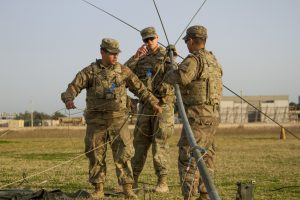
As with all operations, re-establishing and maintaining effective communications is essential. Coordination with local cellular companies will help in identifying key terrain as external parties seek to establish temporary communications until inoperable systems can be brought back online. It would be wise to back up communications plans with steps for partners to take when power, cellular, and other infrastructures are down, thus providing means to act in the absence of routinely available forms of information exchange. These could include pre-disaster designation of “information rally points” where collaboration could be carried out via word of mouth until the reestablishment of other forms of communication is achieved. An additional required capability that needs to be developed is the means to communicate coordinates in three-dimensions to all prospective partners, given megacities’ extensive above ground, ground level, and subterranean infrastructure.
 Partner nations should take advantage of disasters as sources of lessons learned. As artificial intelligence matures, government authorities should employ it to capture and analyze evacuation patterns, record damage to utilities, and otherwise support improved planning and response during future events. This assistance could include prioritizing response and recovery tasks, orchestrating assets, and proposing solutions to traffic management, power distribution, and other challenges during periods of disaster-induced reduced capacity. LTG Kazuaki Sumida, Commanding General, Ground Component Command, JGSDF, pointed out that AI can assist by rapidly sifting through social media, supporting recovery operations.
Partner nations should take advantage of disasters as sources of lessons learned. As artificial intelligence matures, government authorities should employ it to capture and analyze evacuation patterns, record damage to utilities, and otherwise support improved planning and response during future events. This assistance could include prioritizing response and recovery tasks, orchestrating assets, and proposing solutions to traffic management, power distribution, and other challenges during periods of disaster-induced reduced capacity. LTG Kazuaki Sumida, Commanding General, Ground Component Command, JGSDF, pointed out that AI can assist by rapidly sifting through social media, supporting recovery operations.
Conducting thorough expert reviews of megacity readiness to withstand natural or man-caused disaster would assist in reducing post-disaster suffering and recovery costs. Common sense actions such as moving backup generators, control panels, and fuel sources to less exposed locations is an example, one that should bring to mind the need to reconsider current standards in that regard, given rising sea levels.
If you enjoyed this post, please see:
– This conference’s complete Proceedings, as well as select speakers’ slide presentations, presenter biographies, and conference agenda. (Note that additional slide decks and the audiovisual files of actual speaker presentations and panel remarks will be posted in the coming weeks as they are received and cleared for release).
– Last year’s Multi Domain Battle (MDB) In Megacities Conference agenda, presenter biographies, slide decks, associated videos of presentations, and conference Proceedings.
– The following MadSci blog posts addressing megacities:
-
- My City is Smarter than Yours! by Pat Filbert
-
- Integrated Sensors: The Critical Element in Future Complex Environment Warfare, by Dr. Richard Nabors
-
- Classic Planning Holism as a Basis for Megacity Strategy and Three Futurist Urban Scenarios, both by Dr. Nir Buras
– For additional insights regarding combat in urban terrain, please also listen to the following podcasts, hosted by our colleagues at Modern War Institute:
• The Battle for Mosul, with COL Pat Work
• The Future Urban Battlefield, with Dr. Russell Glenn
Disclaimer: The views and opinions expressed in this document do not necessarily reflect the official policy or position of the U.S. Government, the United States Army, U.S. Army Pacific (USARPAC), Training and Doctrine Command (TRADOC), Army Futures Command (AFC), Japan Self-Defense Force, Australian Army, or any other organization.
* Some sources state that the portion of those rescued by community members is as high as 95%.

